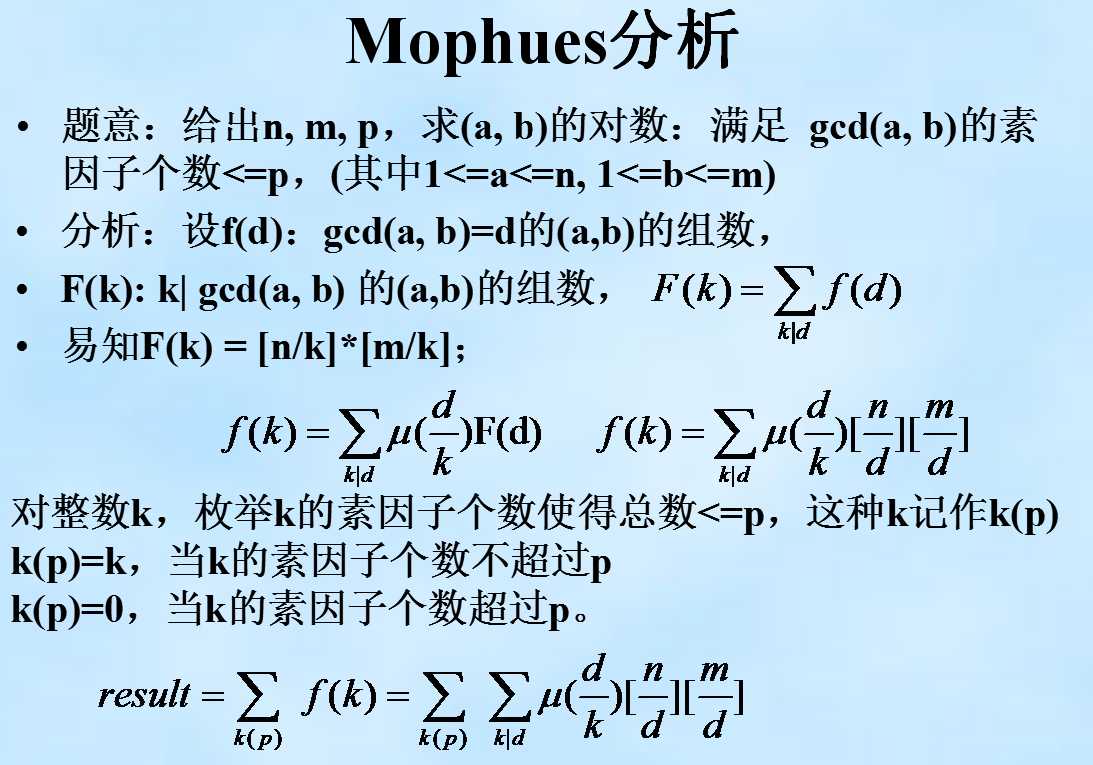标签:style can ica %x code span gcd type 因子
Time Limit: 2000/1000 MS (Java/Others) Memory Limit: 327670/327670 K (Java/Others)
Total Submission(s): 1669 Accepted Submission(s): 675
Problem Description
As we know, any positive integer C ( C >= 2 ) can be written as the multiply of
some prime numbers:
C = p1×p2× p3× ... × pk
which p1, p2 ... pk are all prime numbers.For example, if C = 24, then:
24 = 2 × 2 × 2 × 3
here, p1 = p2 = p3 = 2, p4 = 3, k = 4
Given two integers P and C. if k<=P( k is the number of C‘s prime factors), we
call C a lucky number of P.
Now, XXX needs to count the number of pairs (a, b), which 1<=a<=n , 1<=b<=m, and
gcd(a,b) is a lucky number of a given P ( "gcd" means "greatest common
divisor").
Please note that we define 1 as lucky number of any non-negative integers
because 1 has no prime factor.
Input
The first line of input is an integer Q meaning that there are Q test cases.
Then Q lines follow, each line is a test case and each test case contains three
non-negative numbers: n, m and P (n, m, P <= 5×105.
Q <=5000).
Output
For each test case, print the number of pairs (a, b), which 1<=a<=n , 1<=b<=m, and gcd(a,b) is a lucky number of P.
Sample Input
2
10 10 0
10 10 1
Sample Output
63
93
Source
2013 ACM/ICPC Asia Regional Hangzhou Online
Recommend
liuyiding | We have carefully selected several similar problems for you: 6022 6021 6020 6019 6018
//Source:http://acm.hdu.edu.cn/showproblem.php?pid=4746
Description(题意):
任何整数C
( C >= 2 )都可以写成素数之积
C = p1×p2×
p3×
... × pk
其中, p1, p2 ... pk 是素数。如
C = 24, 则
24 = 2 ×
2 × 2
× 3,
其中, p1 = p2 = p3 = 2, p4 = 3, k = 4.
给定两整数 P和 C,
若 k<=P ( k是
C的素因子个数),称
C是P的幸运数.
现小X需计算的点对 (a,
b)的个数,其中1<=a<=n
, 1<=b<=m, gcd(a,b)是 P的幸运数
( “gcd”是最大公因数).
注意:因为1无素因子,定义1为任何非负数的幸运数.
Input
首行有一个整数 T,表示有 T 组测试数据.接下来有T行,每行是一种测试数据,含3个非负整数n, m 与P (n, m, P <= 5×105. T <=5000).
Output
对每种测试数据,输出对 (a, b)的个数,其中 1<=a<=n , 1<=b<=m, 且 gcd(a,b) 是 P的幸运数.
Sample Input
2
10 10 0
10 10 1
Sample Output
63
93

//num[j]记录j的因子数。 //g[j][num[i]]用于计算具有相同个数的素因子的i的?(j/i)之和, #include<cstdio> #include<iostream> using namespace std; typedef long long ll; const int M=5e5+5,N=19; int n,m,p,T,g[M][N],num[M]; int tot,prime[M/3],mu[M];bool check[M]; int calc(int y,int x){ int res=0; while(!(y%x)) y/=x,res++; return res; } void sieve(){ n=5e5;mu[1]=1; for(int i=2;i<=n;i++){ if(!check[i]) prime[++tot]=i,mu[i]=-1; for(int j=1;j<=tot&&i*prime[j]<=n;j++){ check[i*prime[j]]=1; if(!(i%prime[j])){mu[i*prime[j]]=0;break;} else mu[i*prime[j]]=-mu[i]; } } for(int i=2;i<=n;i++) if(!num[i]) for(int j=i;j<=n;j+=i) num[j]+=calc(j,i); for(int i=1;i<=n;i++) for(int j=i;j<=n;j+=i) g[j][num[i]]+=mu[j/i]; for(int i=1;i<=n;i++) for(int j=1;j<19;j++) g[i][j]+=g[i][j-1]; for(int i=1;i<=n;i++) for(int j=0;j<19;j++) g[i][j]+=g[i-1][j]; } ll solve(int n,int m,int p){ if(p>=19) return 1LL*n*m; if(n>m) swap(n,m); ll ans=0; for(int i=1,pos=0;i<=n;i=pos+1){ pos=min(n/(n/i),m/(m/i)); ans+=1LL*(n/i)*(m/i)*(g[pos][p]-g[i-1][p]); } return ans; } int main(){ sieve(); for(scanf("%d",&T);T--;){ scanf("%d%d%d",&n,&m,&p), printf("%I64d\n",solve(n,m,p)); } return 0; }
标签:style can ica %x code span gcd type 因子
原文地址:http://www.cnblogs.com/shenben/p/6748126.html